Elevated Accountability: The Role of California SB 326, SB 721 in Exterior Elevated Element Safety

Senate Bills 721 (SB 721) and 326 (SB 326) are two pieces of California legislation related to the inspection and safety of wood framed balconies, decks, elevated walkways, and stairs in residential buildings. Legislators introduced these bills in response to tragic incidents of a balcony collapse in Berkeley, California, and a stairway collapse in Folsom, California, both of which occurred in 2015 and resulted in several fatalities.
In 2018, SB 721 became the first law in California to introduce the inspection of exterior elevated elements (E3s) for multifamily buildings, requiring inspections on a six-year cycle. The bill defines E3s as “balconies, decks, porches, stairways, walkways, and entry structures that extend beyond exterior walls of the building and which have a walking surface that is elevated more than six feet above ground level.” E3s are designed for human occupancy and rely on wood or wood-based products for structural support or stability. An E3 also includes the associated railings and guard-walls.
Inspections must be performed by a qualified individual (e.g. licensed architects, civil or structural engineers, certain building contractors, or certified building inspectors). Inspections must sample at least 15 percent of each E3 type in a property and require “direct visual examination or comparable means,” often necessitating exploratory openings where finishes conceal structural elements. These openings are often destructive in nature as they require removing or cutting through the finishes. The purpose of the inspections is to “determine that exterior elevated elements and their associated waterproofing elements are in a generally safe condition, adequate working order, and free from any hazardous condition caused by fungus, deterioration, decay, or improper alteration.” Any conditions observed to be of life-safety concern must be reported to the owner immediately and reported to the local code enforcement agency within 15 days of the inspection. The owner is required to provide temporary repairs or shoring to address the life-safety concerns within the same period.
Following the inspections, the inspector must submit a stamped and signed report to the owner within 45 days. The report must address the elements’ current condition through narrative and photographs, provide repair recommendations and any recommendations for further inspections, and include a statement of the expectations for the future performance of the E3s until the next inspection cycle. Owners must file for a permit within 120 days of the report and complete the repair within 120 days of permit approval for non-emergency repairs.
Although an early SB 721 draft covered condominiums and other “common interest development” buildings, the legislature removed this provision before finalizing the bill. SB 326, which focuses on common interest development buildings, was passed in 2019 to close this gap. Although similar in scope and intent with SB 721, SB 326 mandates inspecting sufficient units every nine years to provide 95 percent confidence that the sample’s results reflect the condition of the whole. Only licensed civil engineers (added by California Senate Bill 2114), structural engineers, or architects can perform SB 326 inspections. SB 326 leaves the decision of exploratory openings up to the inspector’s judgement, rather than requiring direct visual observation of structural elements. Like SB 721, SB 326 mandates immediate preventive measures if a life-safety issue exists. The inspector must provide the report to the association, and if an E3 poses an immediate safety threat, submit it to local code enforcement within 15 days. There is no timeline for completing the repairs identified in the report for SB 326 inspections.
SB 326 and SB 721 inspections do not require comparing existing E3s to current building codes. Both bills focus on evaluating the condition of E3s to ensure they are functional, free from damage, deterioration, or decay, and not at risk of partial or complete failure.
These two E3 inspections bills may introduce a level of confusion for California property owners, associations, and inspectors. In response, this article aims to provide recommendations to practitioners by offering insights into the nuances of each bill.
Publisher
Structure